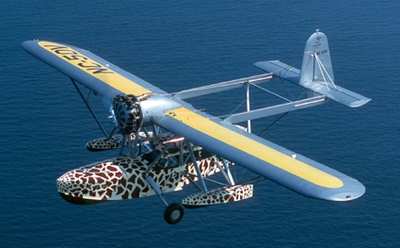by ANN Correspondent Tom Griffith
Minnesota resident Greg
Herrick had a dream that many of us in aviation have also harbored:
to preserve classic aircraft, to build a collection of them, to fly
them and show them off to everyone. But, and it's a BIG but,
he has the financial wherewithal we regular folks can only dream
of. He sold his mail-order computer business, Zeos
International, in 1994 and netted millions of bucks. He used
some seven million of those bucks to acquire forty classic aircraft
and a place to keep them. By definition, "classic aircraft"
are those that were produced between WWI and WWII (roughly 1918
through 1939) - there were over 180 aircraft manufacturers at the
time, and not all of them produced true classics. Luckily
enough of the true classics survived, or more specifically a piece
of this aircraft and a piece of that aircraft survived and many
have been restored, or in some cases, recreated from parts of an
original. The collection is stored at his Golden Wings Flying
Museum at the Anoka County Blaine-Airport near Minneapolis.
The museum is aptly named, since his treasures are from the Golden
Age of flight.
After accumulating one of the largest private collections of
such aircraft (each one comes with a story from Greg about just
what he had to do to acquire it), he decided that a grand way to
feature them to as many people as possible would be to recreate
what was called the "Commercial Airplane Reliability
Tours." These Tours were flown yearly from 1925 through
1931. They were sponsored by Henry Ford.
It occurred to Greg that he could do something to contribute to
the Bicentennial of Powered Flight events to take place in 2003 -
this idea blossomed into what is called the "National Air Tour
2003." Among the many tributes to the 100th anniversary of
the year of the Wright's first flight, this is one of the biggest
undertakings. The Tour began on 8 September and will end on
24 September. The Tour started in Dearborn, Michigan at
Dearborn Proving Ground (formerly Ford Airport). Edsel Ford,
II, the great-grandson of Henry Ford waved the starter's flag to
kick things off. The Tour will also end there - there are a
total of 26 cities on the Tour and the trip covers about 4,000 air
miles. The route will follow that which would have
occurred on the 1932 Tour, but the Depression had hit America so
hard that many of the cities on the trip could not afford the money
to participate in the Tour.
The Tour includes about 25 classic aircraft, along with several
modern planes that serve as support planes. Some lucky
members of various media organizations were invited to fly a leg of
the Tour. I was fortunate to be invited by Suzanne Fedoruk of
the NAT 2003 team to fly on the Tulsa, OK to Ft. Worth, TX
leg. I'm getting long in the tooth, but I wasn't around
during the original Tours, and I really do NOT think that I'll be
around for the Bicentennial of Powered Flight in 2103!
Naturally I chose the Tulsa - Ft. Worth leg because my home is in
Ft. Worth, and Tulsa is a short airline flight from the Dallas-Ft.
Worth area.

As of the time of this preview article, Suzanne gave me a list
of possible aircraft that I might fly in - I'd be in one plane for
the whole trip, obviously, since they wouldn't have the capability
of doing plane-to-plane transfers as they wing their way!
To facilitate getting all of these antiques from one town to the
next, they spread their take-off times over a fairly long period of
time. The Tour is winging its way from Wichita, Kansas to
Tulsa, Oklahoma and at the same time, I am sitting at Gate 12 at
Love Field waiting for my everyday Boeing 737-200 to fly me to my
appointment with this historic undertaking. The flight on the
737 will last about 50 minutes and depending upon my ride home, it
will take around 3 hours that will pass all too quickly.
 ANN's Daily Aero-Term (12.14.25): Local Airport Advisory (LAA)
ANN's Daily Aero-Term (12.14.25): Local Airport Advisory (LAA) Airborne 12.08.25: Samaritans Purse Hijack, FAA Med Relief, China Rocket Fail
Airborne 12.08.25: Samaritans Purse Hijack, FAA Med Relief, China Rocket Fail ANN's Daily Aero-Linx (12.15.25)
ANN's Daily Aero-Linx (12.15.25) Airborne 12.10.25: New Gulfstream, ATC Integrator, Outrageous FFZ User Fees
Airborne 12.10.25: New Gulfstream, ATC Integrator, Outrageous FFZ User Fees Airborne-NextGen 12.09.25: Amazon Crash, China Rocket Accident, UAV Black Hawk
Airborne-NextGen 12.09.25: Amazon Crash, China Rocket Accident, UAV Black Hawk



